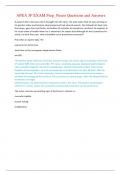APEA 3P EXAM Prep_Neuro Questions and Answers
A patient who is 82 years old is brought into the clinic. His wife states that he was working in
his garden today and became disoriented and had slurred speech. She helped him back into
the house, gave him cool fluids, and within 15 minutes his symptoms resolved. He appears in
his usual state of health when he is examined. He states that although he was scared by the
event, he feels fine now. How shouldthe nurse practitioner proceed?
Prescribe an aspirin daily. Re-
examine him tomorrow.
Send him to the emergency department.Order
an EKG.
This patient likely suffered a transient ischemic attack. He needs urgent evaluation with head
CT and/or MRI, ECG, lab work (CBC, PTT, lytes, creatinine, glucose, lipidsand sedimentation
rate); possible magnetic resonance angiography, carotid ultrasound, and/or transcranial
Doppler ultrasonography. He is at increased risk of stroke within the first 48 hours after an
event like this one. On initial evaluation, themost important determination to be made is
whether the etiology of the stroke or TIA is ischemic or hemorrhagic. After this determination,
treatment can begin.
Unfortunately, this determination cannot be made in the clinic. The patient needsurgent
referral to a center where this evaluation and possible treatment can be performed.
The most common presenting sign of Parkinson’s disease is:
muscular rigidity.
tremor. falling.
bradykinesia.
,Approximately 70% of patients with Parkinson’s disease have tremor as the presenting
symptom. The tremor typically involves the hand but can involve thelegs, jaw, lips, tongue. It
seldom involves the head. Muscular rigidity and bradykinesia are two less common presenting
signs.
When should medications be initiated in a patient who is diagnosed with Parkinson’sdisease?
As soon as the disease is diagnosed
When symptoms interfere with life’s activities
When nonpharmacologic measures have been exhaustedAfter MRI
and CT have ruled out stroke or tumor
The medications used to treat patients who have Parkinson’s disease do not preventthe
progression of the disease. Therefore, it is not necessary to start medications until symptoms
interfere with the patient's quality of life. Levodopa is often used initially at the lowest dose
that helps a patient manage symptoms. It can be titratedupward as needed. Orthostatic
hypotension is a common side effect of levodopa, so blood pressure should be monitored
closely.
A 72-year-old patient with history of polymyalgia rheumatica complains of new onset,
unilateral headache and visual changes. Her neurologic exam is otherwise normal. Her CT
results are WNL. ESR is 75 (Normal: 0-29). VS: BP 140/82, HR 67, RR18, T 100. What is the
most likely reason for her symptoms?
Transient ischemic attack
Temporal arteritis
Meningitis
CVA
Polymyalgia rheumatica (PMR) is a chronic inflammatory condition that produces morning
stiffness in the neck, shoulders, and hips. Its peak incidence is 70-80 years old. PMR is
commonly associated with temporal arteritis, also known as giant cell arteritis. Temporal
arteritis is a chronic vasculitis of the medium and large vessels. Temporal arteritis is
characterized by new onset unilateral temporal headache, abrupt onset of visual disturbances,
elevated sedimentation rate, jaw claudication, and unexplained fever. This is best diagnosed
by temporal artery biopsy. She shouldbe referred to neurology for evaluation today.
What recommendation should be made to an older adult who is diagnosed with mild
dementia?
, Driving will probably not increase your risk of an accident.
The healthcare provider should recommend that the patient stop driving today.
The healthcare provider should recommend assessment of driving to determine riskof an
accident.
The patient may continue to drive as long as he feels comfortable.
Dementia independently increases the risk of motor vehicle accidents if the patientdrives.
The healthcare provider should discuss this with the patient and a family member if a family
member is present during the older adult’s evaluation.
Depending on the degree of impairment, the healthcare provider could recommendstopping
driving, or recommend that an assessment be done. The assessment is usually completed by
either an occupational or physical therapist or someone trained to assess this.
A person with 20/60 vision:
is legally blind.
will have difficulty reading a newspaper.
will be unable to see the big “E” on the eye chart.has
better vision than someone with 20/80 vision.
Using the Snellen nomenclature for describing visual acuity (example 20/80), the first
number represents the test distance. In most cases this is 20 feet. The secondnumber
represents the distance at which the average eye can see the letters on a specific line of the
chart. In other words, the examinee can see at 20 feet what an average eye (20/20) can see
at 80 feet. 20/80 is a measure of distant vision, not near vision such as reading a newspaper.
The big “E” represents 20/200 vision.
20/200 is considered legally blind by most standards.
A patient reports a history of transient ischemic attack (TIA) 6 months ago. His dailymedications
are lisinopril, pravastatin, and metformin. After advising him to quit smoking, what intervention
is most important in helping to prevent stroke in him?
Auscultation of carotid arteries at each visit
Taking low dose aspirin daily
Assessing hemoglobin A1C every 3-6 months
Encouraging smoking cessation at each visit
Antiplatelet therapy, usually aspirin, inhibits the enzyme cyclooxygenase and reduces
thromboxane A2 production, which stimulates platelet aggregation. Thus,




